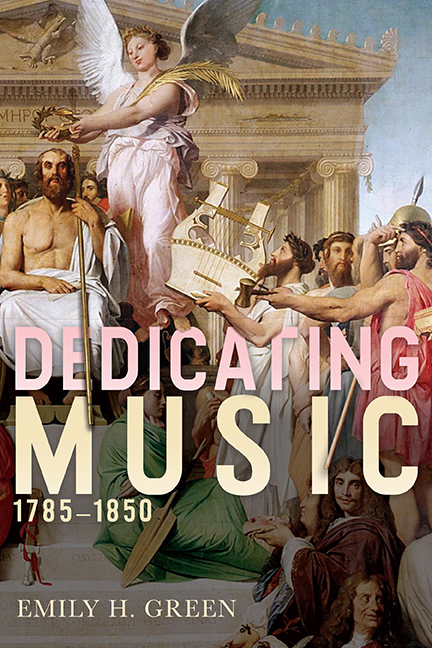Book contents
- Frontmatter
- Dedication
- Contents
- List of Illustrations
- Acknowledgments
- Introduction: Encountering Dedications
- Part One Maintaining Early Modern Models
- Part Two Commodifying the Composer
- 3 Sociability and Celebrity
- 4 Influence, Arrangement, and Authorship
- Epilogue: Dedications and Romanticism
- Appendix: Dedicatory Epistles
- Notes
- Bibliography
- Index
3 - Sociability and Celebrity
from Part Two - Commodifying the Composer
Published online by Cambridge University Press: 03 September 2019
- Frontmatter
- Dedication
- Contents
- List of Illustrations
- Acknowledgments
- Introduction: Encountering Dedications
- Part One Maintaining Early Modern Models
- Part Two Commodifying the Composer
- 3 Sociability and Celebrity
- 4 Influence, Arrangement, and Authorship
- Epilogue: Dedications and Romanticism
- Appendix: Dedicatory Epistles
- Notes
- Bibliography
- Index
Summary
The only gift is a portion of thyself. Thou must bleed for me. Therefore the poet brings his poem; the shepherd, his lamb; the farmer, corn; the miner, a gem; the sailor, coral and shells; the painter, his picture; the girl, a handkerchief of her own sewing. This is right and pleasing for it restores society in so far to its primary basis, when a man's biography is conveyed in his gift, and every man's wealth is an index of his merit.
—Ralph Waldo Emerson, “Gifts”Pierce Tempest and Isaac Fuller included in their edition of Cesare Ripa's Iconologia or Moral Emblems (1709) an allegorical engraving of friendship, which they described: “A Youth crown'd with a Garland of several Flowers, in a green, loose Garment, holding a Crystal Vase, in his right Hand, full of Claret, which he offers with a seeming Cheerfulness” (figure 3.1). Other editions of the famous collection of iconography also link friendship to gestures of offering. Johann Georg Hertel's elaborate Historiae et Allegoriae from 1758–60 (figure 3.2) illustrates yet more details: the main figure draped in white, the color of truth; a skull beneath her feet, showing that friendship outlasts death; the dog, embodying loyalty; and finally, an image of Classical figures giving and reciprocating, held in the foreground by a cherub.
Gift giving has long been associated with representations of friendship, and dedications exemplify this connection. Previous chapters here have examined the ways they demonstrate generosity and humility, but dedications also capture cultural orientations toward intimate relationships and their public facade. That link is apparent, for instance, in the host of early to mid-nineteenth-century dedications to friends, as in Ries's offering “à son ami” Beethoven (figure 3.3, discussed below), and is also underlined in composer- biography, an emerging literary genre that began its life in the early nineteenth century recounting anecdotal tales of sociability. Dedications and anecdotal biographies are so connected in their illustration of friendship that we can argue that they manifested the same impulse to present their subjects as idealized embodiments of friendship itself. Further, as composers became more modern celebrities toward the mid-century, standing for a brand name, dedications remained ego-documents:4 they related the commoditized printed page to an increasingly commoditized version of the author.
- Type
- Chapter
- Information
- Dedicating Music, 1785–1850 , pp. 109 - 137Publisher: Boydell & BrewerPrint publication year: 2019

